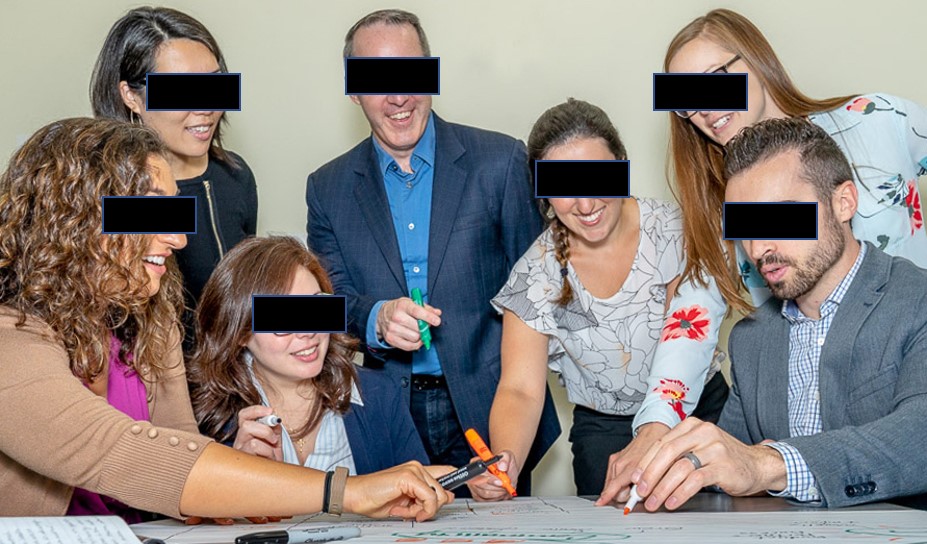Using an innovation toolkit can be difficult in a classified environment. There may be restrictions on what information can be shared, where it can be stored, and who it can be communicated with. What do you do with the notes? What if someone says something they aren’t supposed to say? Is there the right level of system access to present the appropriate slides? Are creativity and innovation inherent aspects of a culture in a classified, secure workspace?
These and other questions may be asked when considering innovating in a classified environment. The short answer is: Yes! You can certainly innovate in such an environment. It may require some creativity and flexibility to pull it off.
Let’s make up a scenario: You feel that your team isn’t considering all the alternatives for a given decision. You are aware of some ideation activities and wonder if you could facilitate an innovation activity with your team. You start thinking about the secure environment you work in. Your mind begins to fill with doubt as you ask yourself about all the hurdles you’ll have to jump over to pull this off. Questions like: Who would I invite? What level of classification would the discussion be held at? What if our notes can be compiled into an even higher classification level that the room isn’t accredited for (let alone the clearance levels of the attendees)? Is there a computer in that room with access to the network required to present certain slides? Are cameras allowed? Do I know the new security classification guide (SCG) well enough to facilitate the discussion? What will I do with all of those sticky notes and poster boards when the meeting is over? Do I need to find an official courier to get the notes to a different facility?
This may be a scenario you can relate with. It’s not easy to answer all of these questions, especially when these activities may be new to your organization. Here are a few tips for pulling this type of exercise off:
Don’t overthink it
It’s easy to overcomplicate an idea to the point of never seeing it through. If this applies to you; simplify. Sometimes, getting people in a room where they feel safe to talk about potentially unpopular ideas is half the battle. There is a first for everything and if people feel heard then the power of diverse thinking can run its course.
Set clear goals
It may require some effort to get management on board (or not, depending on the culture of your organization). An innovation workshop could pull important people from their important tasks. This is why you need to clearly communicate the goals of your meeting/workshop. This will also help you to organize and facilitate the event, as you will have a constant reminder of what you are actually trying to accomplish.
Communicate early, communicate often
In general, your leaders may not appreciate being surprised about an event they didn’t know about (and that cost them precious resources). If you think this may apply to you, communicate your idea early on. It might be wise to start with an immediate supervisor, as they may have a working knowledge of available resources, etc. Finding a champion amongst your team can also help “sell” the idea. Provide examples of similar organizations performing similar activities. You could even tie your activity into an industry-accepted activity that your organization regularly employs.
Plan for success
If you are concerned that your discussion/notes may result in classified information, plan for it. Reserve a space that can handle the highest classification level you think the conversation and/or notes may go to. Only invite people that have that access. Coordinate with your local security representative to make sure the room is ready, the people are cleared, and that you have a plan for the written material that may leave the meeting and need to be stored. If possible, invite someone strongly familiar with the SCG to give a short SCG overview. In lieu of an expert, the SCG itself should be on-hand for reference. If anything will be related to Intelligence, invite your local Intelligence representative to not only give a short presentation (e.g. a threat briefing) at the beginning of the workshop, but to participate as well.
Use appropriate tools
You may feel the need to provide high fidelity presentation, facilitation and/or note-taking material. While this can certainly be helpful (slides, markers, posters, toys, etc.), don’t let it bog you down to the point of not doing the activity at all. Getting authorization to run certain software may be a bridge too far. In addition to having a licensed copy of the software purchased and ready, there is also a need to have an authority to load and operate the software. In short, in addition to pen & paper, plan on only having the office automation applications available in the facility. If you can get some sticky notes, paper, and a handful of colored sharpies, call it a win.
Expand the buy-in
You don’t want to do this in a vacuum. Ask people how they would like to contribute. Bring in some diversity of thought. Allow people to do what they are the best at. This creates more buy-in while also having a second set of eyes review any policies or procedures you aren’t sure about.
Is it always easy to pull this off? Probably not. Still, as you try and show the fruits of your efforts, your organization could recognize the positive change and embrace similar techniques going forward.


